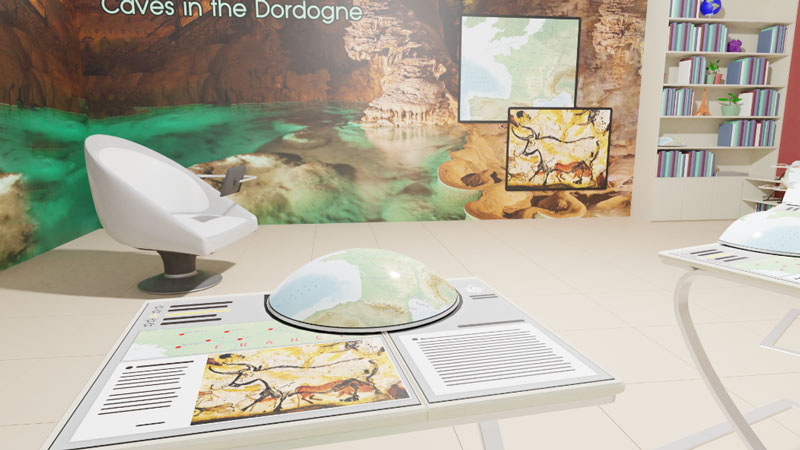by Asterios Leonidis, Maria Korozi, Margherita Antona and Constantine Stephanidis (FORTH-ICS)
The ICS-FORTH Ambient Intelligence (AmI) Programme is a long-term horizontal interdisciplinary RTD Programme aiming to develop pioneering human-centric intelligent technologies and environments that seamlessly support everyday human activities and enhance well-being through human-technology symbiosis.
Acknowledging the omnipotent impact of technology on the domain of education, we have pursued the vision of a student-oriented and educator-friendly “Intelligent Classroom” that supports students in their journey to acquiring knowledge. The classroom simulation space [R1] located within the AmI Facility [L1] provides an ideal testbed for assessing the effects of intelligent technologies on key aspects of the educational process. Designing and developing ambient applications that shape the “Intelligent Classroom” is an ongoing activity and an open research endeavour, integrating and assessing emerging technologies that introduce new educational opportunities and interaction paradigms.
More specifically, the hardware infrastructure includes both commercial and custom-made artefacts, which are embedded in traditional classroom equipment and furniture, while various ambient facilities are also available for monitoring the overall environment and the learners' activities. One of the key classroom artefacts, the “Smart Student Desk”, has been drastically re-designed since its first realisation in 2010, when it featured a vision-based back-projected multi-touch screen. Now, the desk artefact features a more appealing and ergonomic design, embedding a 24-inch wide, all-in-one computer, secured in a rotatable steel frame. At the same time, the next version of the student desk is already under development, featuring a modular design, where customisable surfaces can be added or removed on demand, in order to support the specific needs of each course. This new generation desk will further enhance students’ engagement and motivation, offering hands-on experience and providing personal study spaces with specialised equipment.

Figure 1: 3D representation of the “Intelligent Classroom” displaying the “Smart Student Desk”, the “Intelligent Classroom Board” and the “Teacher Workstation”.
The design process of the classroom board followed a course similar to that of the students’ desk. The first version of the “Intelligent Classroom Board” featured a commercially available interactive white board, while the second version used a 70-inch, 4K TV along with a multi-touch panel in order to enable collaboration and increase the interactive area. Following the recent advances in projection technologies, which can transform plain walls into interactive displays, the current version of the classroom board extends beyond digital devices; two out of the four walls of the “Intelligent Classroom” (i.e., the wall in front of the entire class and one side wall) act as interactive smart boards, where educational content (e.g., multimedia, notes, exercises) can be presented, while they are also used to create attractive, situational (i.e., course-, topic- and discussion-specific) environments, where students can be immersed into an “environment” (e.g., a cave or a rainforest). Finally, the design of the “Teacher Workstation” has shifted away from the traditional desk and now enables educators to monitor and manipulate every aspect of the “Intelligent Classroom” (e.g., ambient facilities, educational software, intelligent behaviour, automations) from a comfortable technologically-augmented armchair.
The underlying software of the “Intelligent Classroom” has evolved gradually over the years and has now reached a satisfactory level of maturity, creating a unified environment that promotes teaching and learning. In particular, the ClassMATE and the AmI-Solertis [R2] frameworks support fundamental services, such as interoperability of heterogeneous intelligent services, synchronous and event-based communication, resilience, security, etc. Additionally, they empower contextual awareness, thus enabling the classroom to immediately respond and orchestrate the available intelligent artefacts (e.g., boards, desks, walls) in order to effectively and efficiently address the needs of students and educators. Furthermore, such infrastructure features an adaptive content retrieval mechanism and a learners’ behaviour knowledge library, to enable the intelligent environment to personalise the educational content to each student’s actual learning needs. Additionally, the classroom features LECTOR [R3], an educator-oriented platform that helps identify behaviours that require remedial actions (e.g., student is not paying attention) and deliver appropriate interventions when students and teachers need assistance (e.g., a motivational cue to encourage participation, a suggestion to adjust the current pedagogical approach in order to re-engage students). As far as the end-user applications are concerned, CognitOS is a web-based window manager that hosts educational applications and instantiates a common “Look-n-Feel” across the various classroom artefacts, thus transforming the classroom into a unified environment, rather than a group of isolated units. On top of that, CognitOS features mechanisms that enable the initiation of interventions dictated by LECTOR in order to: (i) attract the educator’s attention in problematic situations, and (ii) re-engage distracted or unmotivated students in the educational process.

Figure 2: Snapshots of CognitOS dashboards and multimedia application running on the “Smart Student Desk”.
Up until now, many ambient applications (e.g., teaching Greek as a foreign language, independent living skills training for children with cognitive disabilities) and educational games (e.g., geography game, spelling game) have been implemented for the “Intelligent Classroom”. These applications have been tested through formal evaluation experiments, while dozens of demonstrations offered to visitors of the “Intelligent Classroom” have given the opportunity for informal evaluations. Our future plans include multiple, in-vitro, summative, user-based evaluation experiments with educators and students, in order to assess the effectiveness of each system, as well as the classroom environment as a whole.
Link:
[L1] http://ami.ics.forth.gr
References:
[1] M Korozi, et al.: “ Shaping the Intelligent Classroom of the Future”. In C. Stephanidis & M. Antona (Eds.), HCI International 2019 – Late Breaking Posters, Vol. 37 of the combined Proceedings of HCI International 2019, Orlando, FL, USA, y (pp. 200-212). Springer, 2019
[2] A. Leonidis, et al.: “The AmI-Solertis System: Creating User Experiences in Smart Environments”, in Proc. of PerCAM 17, in the context of the WiMob 2017, Rome, Italy (pp. 151-158), 2017
[3] M. Korozi, et al.: “Lector: Towards Reengaging Students in the Educational Process inside Smart Classrooms”, in P. Horain, et al. (Eds.), Intelligent Human Computer Interaction, Proc. of IHCI 2017, Evry, France (pp. 137-149). Springer, LNCS 10688, 2017
Please contact:
Constantine Stephanidis
FORTH-ICS, Greece
+30 2810 391741











